While much of the world welcomes the New Year with parties and fireworks, traditional New Year celebrations in Japan are far more subdued affairs.
Think leisurely days spent at home with family – eating, watching TV, reading books and playing games – and completing the first shrine visit of the year. That said, there is no lack of celebratory air, preparation or effort when it comes to the special rituals associated with what is the country’s most important holiday.
Osechi ryori refers to the special meaning-laden dishes served in elaborate multi-tiered lacquered boxes and eaten over the first three days of the New Year. Osechi ryori is unique and has a culture all of its own.
So special are Japan’s New Year food traditions, that osechi ryori was specifically mentioned as a key factor in washoku (traditional Japanese cuisine) achieving UNESCO Intangible Cultural Heritage status.
So, just what do the Japanese eat over the New Year and what do each of the dishes mean?
Table of Contents
Origin of osechi ryori
Like many of Japan’s oldest food traditions, the origins of osechi ryori (osechi ryōri, おせち・りょうり, お節料理) are deeply tied to changes in the natural world. As far back as the Nara period (710-794), ritual offerings of food were made to the gods on sechinichi, days considered seasonal turning points when traditional events took place, based off the lunisolar calendar Japan adopted from China.
These offerings were in the form of special ceremonial banquets called “sechie” held at the imperial court. By the Heian period (794-1185), these banquets had become quite extravagant affairs and it wasn’t until the Edo period (1603-1868) that these traditions trickled down from the nobility and became widely practiced by the rest of society. Although osechi was originally eaten several times a year, over time it became specifically associated with the New Year, a tradition that continues until this day.
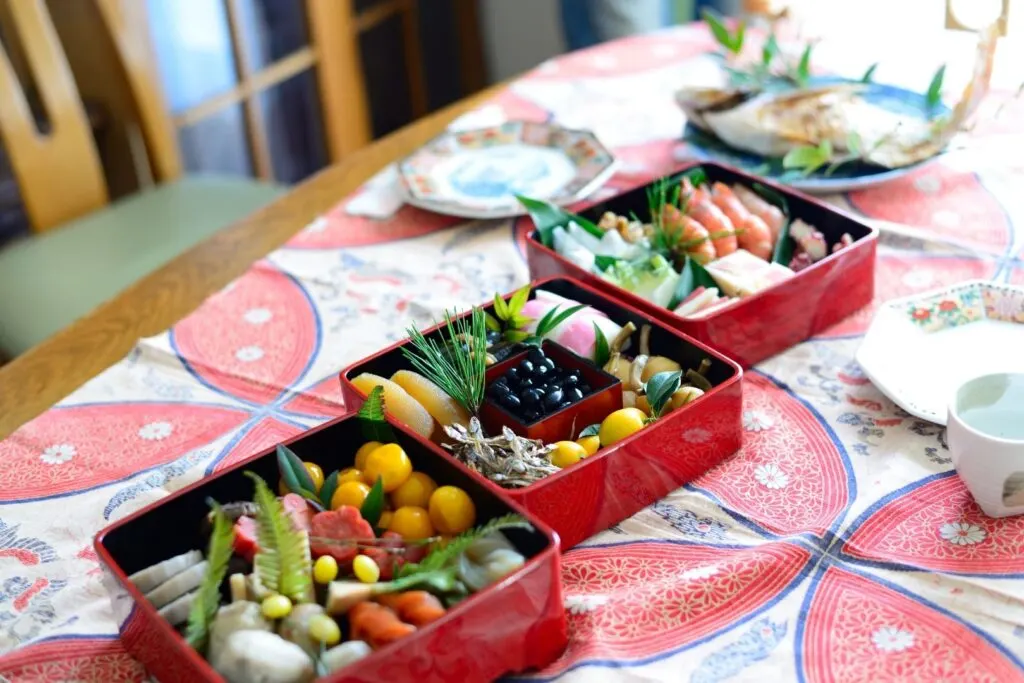
Osechi cuisine features numerous small dishes perfectly presented in multi-tiered lacquered boxes called jubako (jūbako, じゅうばこ, 重箱), akin to a very formal style bento box. As with the dishes and ingredients themselves, there is special consideration and meaning given to the number of tiers, the number and types of dishes that go into each one, and the very act of stacking the meal in this style is said to be “piling up happiness and good fortune”.
Osechi dishes are generally sweet, sour or dried, so they can be kept without refrigeration for the duration of the festivities, which was important before the advent of mod-cons. The dishes are prepared prior to the New Year and then eaten over the first three days. It is said that this tradition began so as not to disturb the gods with the sounds of cooking during the first days of the New Year. It also doubles as a welcome break for the cooks of the household, generally women, to rest and enjoy the festivities with the rest of the family.
New Year’s Eve Food in Japan: Toshikoshi soba
Before we get to the explanation of the various osechi ryori dishes, we should talk about three very important Japanese New Year food and drink traditions that happen before the osechi is eaten. While they are not technically part of osechi, they are integral to the specific food culture of the Japanese New Year. The first is toshikoshi soba or “year-crossing noodles”, which is a hot bowl of soba noodles in soup.
Toshikoshi soba (としこしそば, 年越しそば) is eaten around midnight on New Year’s Eve with various theories behind its origin. One of the most common is that the soba noodles are easily bitten through with your teeth and hence it’s like making a clear cut between one year and the next, leaving any regrets of the past year behind.
Another theory is that the long and fine noodles represent a long life, while other origin stories include simple explanations like garnering strength, as well as happiness and fulfilment from slurping the delicious noodles. A more historical account references the fact that buckwheat flour was once used by goldsmiths to gather up leftover gold dust and hence is related to growing your fortune. Whichever theory you prescribe to, toshikoshi soba is an enduring part of Japan’s New Year food traditions.
Other auspicious ingredients may also be added such as shrimp (usually in tempura form) and kohaku kamaboko fish cake, both of which we’ll discuss below.
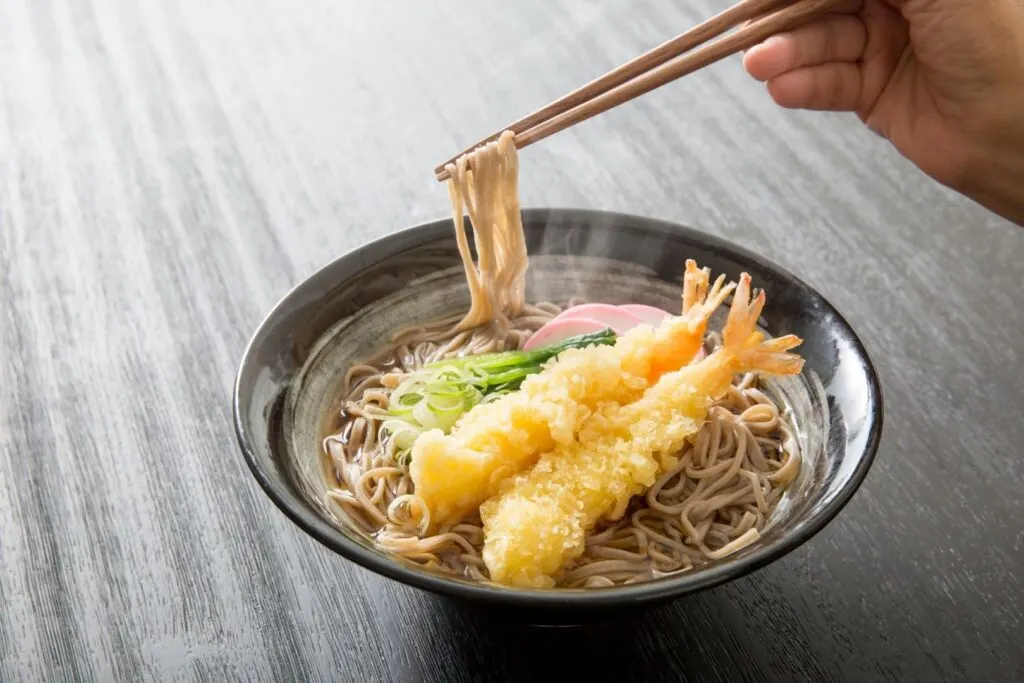
First drink of the Japanese New Year: Otoso
After morning greetings on New Year’s Day, it is customary to drink otoso (お屠蘇, also hyphenated as o-toso, or simply referred to as toso without the honorific). Otoso is a spiced sake containing a combination of various roots, spices and herbs that is said to ward off colds and flus for the coming year.
It is drunk from three differently-sized lacquer sake cups and from youngest to oldest (or starting with the head of the household). Some people combine this practice with osechi and drink it before partaking in the main osechi meal proper.
Find out how to make and drink otoso here.
First meal of the New Year in Japan: Ozoni
The third dish is ozoni (ozōni, おぞうに, お雑煮, also referred to without the honorific as zōni), a soup containing mochi rice cakes that is eaten on New Year’s Day. Mochi is pronounced the same way as the Japanese word “to have” or “to hold” and so is eaten to be able to grab a hold of good luck.
It is said that it should be your first meal of the New Year to ensure good fortune in the coming year. Do be careful eating it, however, as the glutinous rice cakes can pose a choking hazard.
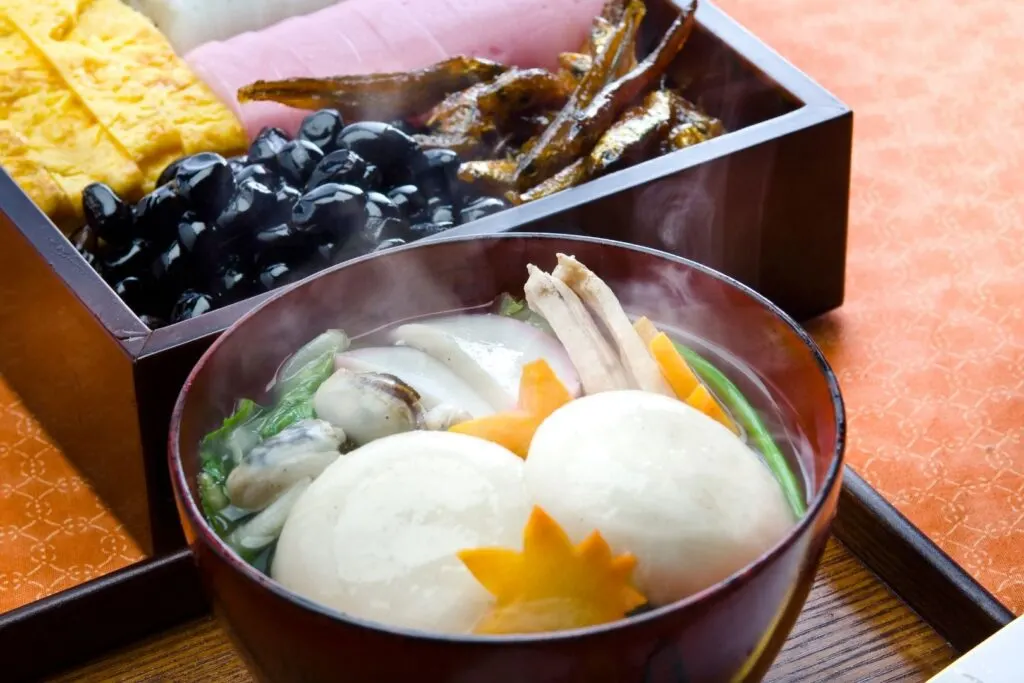
First three days of the New Year: Osechi ryori
With the osechi ryori pre-prepared and these two hot soups eaten, it’s time for the cooks to take off their aprons and enjoy the fruits of their labor. All osechi dishes are designed to be eaten cold, and although no longer necessary thanks to modern technology, they can be preserved for several days without refrigeration thanks to the large amount of sugar, salt and vinegar used in the recipes.
In fact, you’ll find that many people say they don’t much like the taste of osechi thanks to the strong flavors of these natural preservatives. While there are certainly people who enjoy osechi and have their favorite dishes, nowadays osechi is eaten mostly out of tradition more than anything else.
As you will see, making all of these various dishes for osechi at home is incredibly time-consuming, so these days many people choose to pre-order their osechi from restaurants or convenience stores, and there are even eating establishments and hotels that offer osechi banquets as a dine-in service. Expect your shared osechi order to be in the tens of thousands of yen (hundreds of dollars). Some New Year fare, depending on the number and types of dishes ordered, can even venture into six Japanese figures (between US$1,000-2,000).
So just what are the dishes eaten as osechi ryori and why are they eaten over the New Year? Here are typical dishes that form osechi cuisine and the auspicious meanings they symbolize.
Kuromame
Kuromame (くろまめ, 黒豆) are sweetened black soybeans. They symbolize health and therefore the ability to work hard in the coming year.
Kuromame have an incredibly glossy appearance thanks to being simmered on low heat for up to eight hours in sugar and soy sauce. Traditional recipes also call for 2-3 rusty iron nails. Yes, you read that right. Rust (iron oxide) has a chemical reaction with the tannin in the beans, which gives the beans their delectable and uniform rich black color. If you don’t feel like throwing rusty nails into your food, try a reusable iron supplement cooking tool instead.
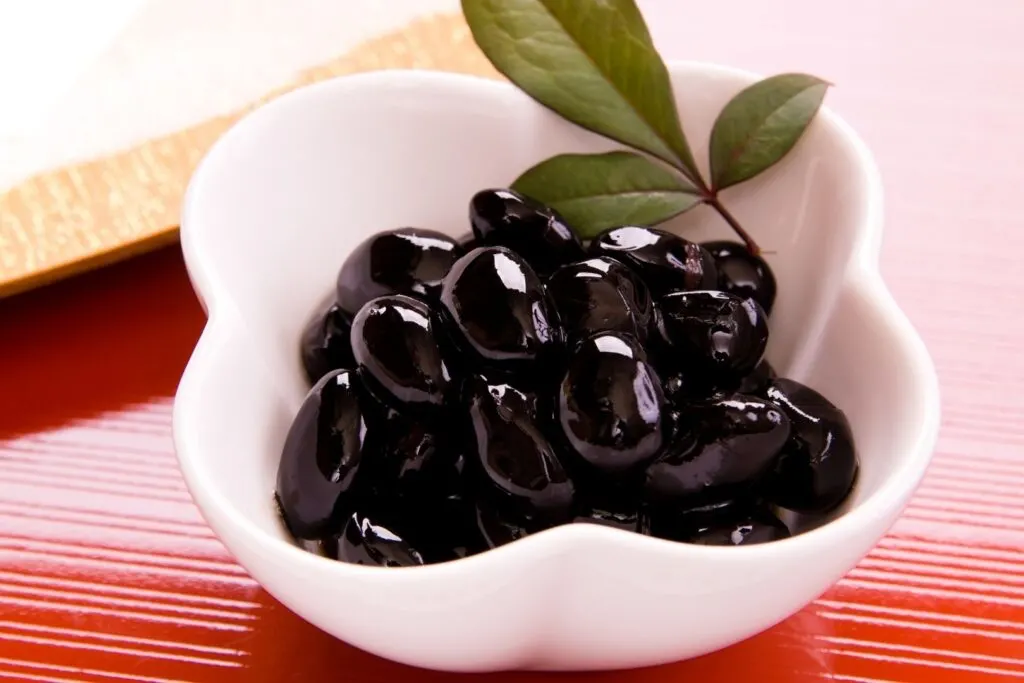
Kazunoko
Kazunoko (かずのこ, 数の子) is herring roe and represents fertility. From the large number of tiny eggs, it’s not difficult to see why, but there is further symbolism here. Kazu means “number” in Japanese, and “ko” means children, and therefore is a wish for many children and grandchildren.
If we delve even further into semantics, the word for herring in Japanese is nishin, which if written with an alternative set of kanji (二親) means “two parents”.
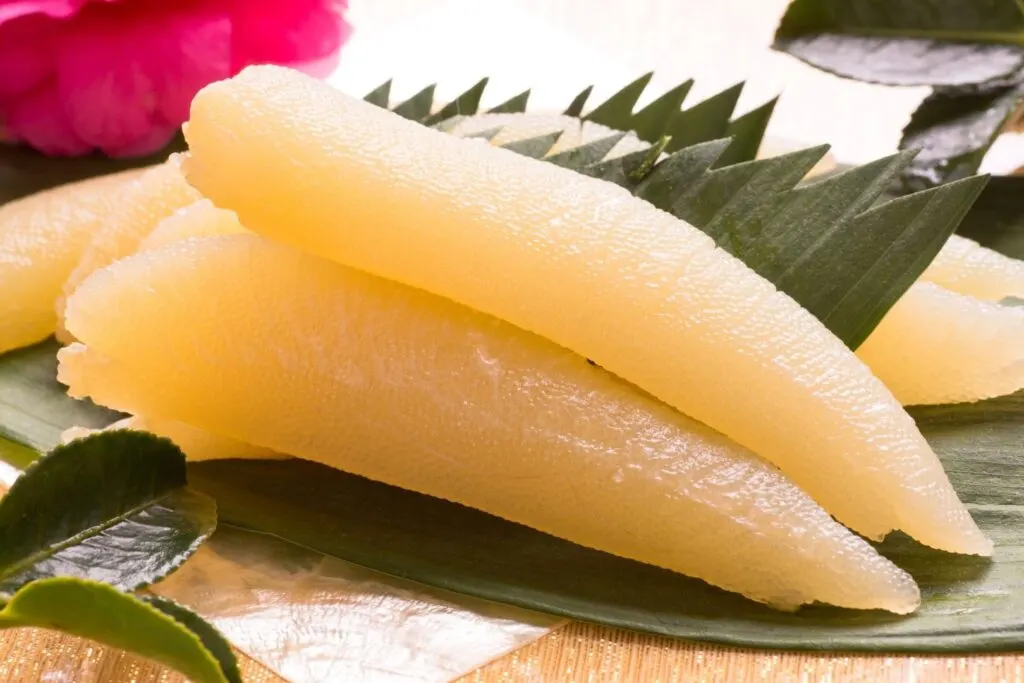
Ikura
Ikura (いくら) or salmon roe is seasoned salmon eggs pickled in soy sauce.
Yep, you guessed it, this is another dish eaten for fertility.
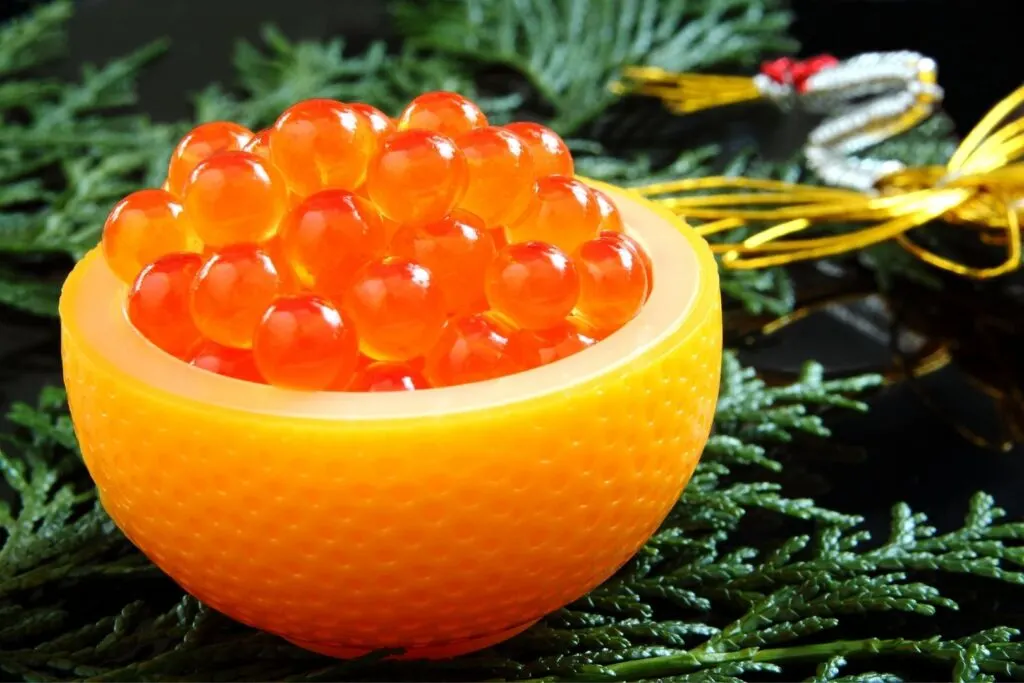
Satoimo
Yet another osechi dish with a similar sentiment for a growing family is satoimo (さといも, 里芋) or taro root. Satoimo has a main tuber with many small tubers growing off it, thereby symbolizing offspring.
It is typically simmered in dashi, sake, soy sauce, mirin, and some sugar.

Tazukuri
Takuzuri (たずくり, 田作り) is sometimes referred to as “candied sardines” in English. It is a dish comprised of toasted baby sardines coated in a honey and soy sauce glaze, and sesame seeds.
The name of this dish literally translates to “making” (作り) “rice fields” (田) as sardines were once used to fertilize rice paddies. As with many ancient rituals, this one symbolizes a bountiful harvest.
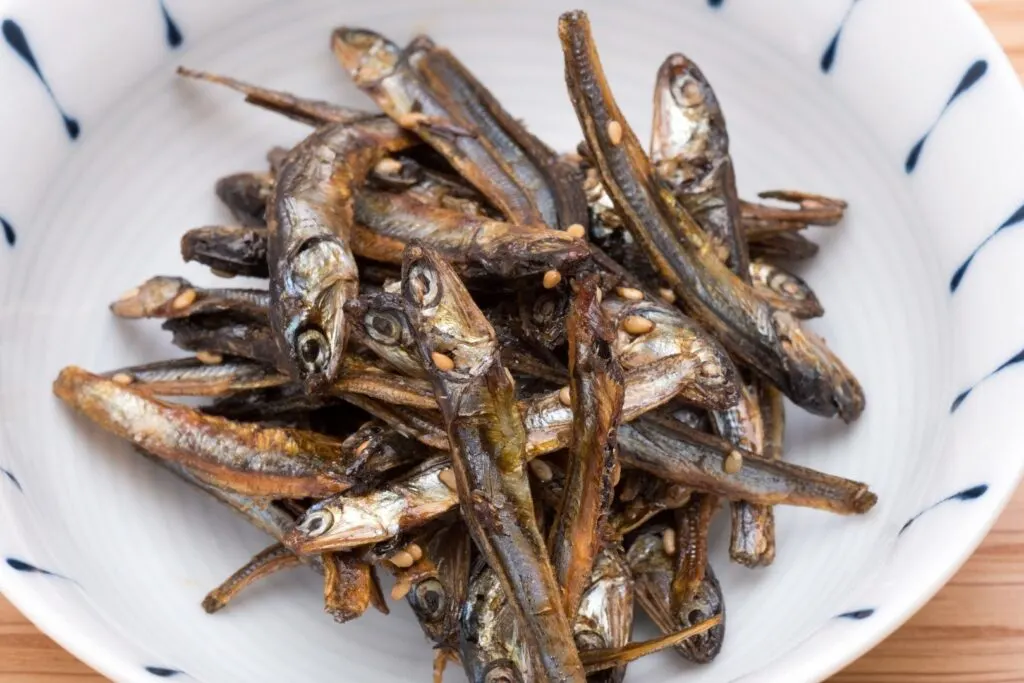
Kohaku kamaboko
Kohaku kamaboko (kōhaku kamaboko, こうはく・かまぼこ, 紅白かまぼこ) is a “red and white fish cake” made of cured surimi paste and partially dyed a pink color (representing “red”). As you may have gathered from the Japanese flag, red and white are auspicious colors in Japanese culture, related to good fortune and celebration.
There’s a special NHK program aired annually on New Year’s Eve called Kōhaku Uta Gassen (Red and White Song Contest) whereby popular male and female music artists compete against each other. The males represent the ‘white’ team and the women ‘red’, the traditional colors of New Year in Japan.
Kohaku kamaboko are often presented in an alternating color pattern and in a half moon shape in osechi, said to represent the first sunrise of the New Year. The “first” of anything in the New Year in Japan is given substantial weight and is said to be important in getting the new year off on the right foot. Waking early to view the very first sunrise of the year is a popular activity on New Year’s Day.
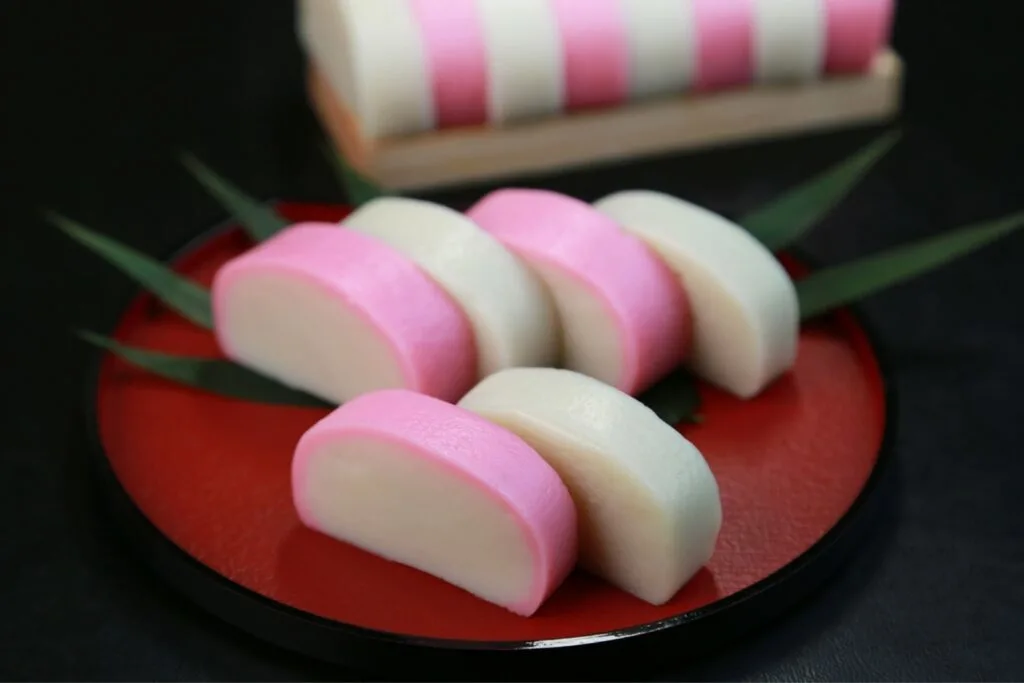
Kohaku namasu
Another osechi dish with the word kohaku in it, kōhaku namasu (こうはく・なます, 紅白なます) is a carrot and daikon radish salad pickled in a sweet vinegar.
The colors resemble ‘red and white’ and hence once again represent the celebratory colors of the Japanese New Year. You’ll often find vinegared tako (octopus) in osechi for the same reason.
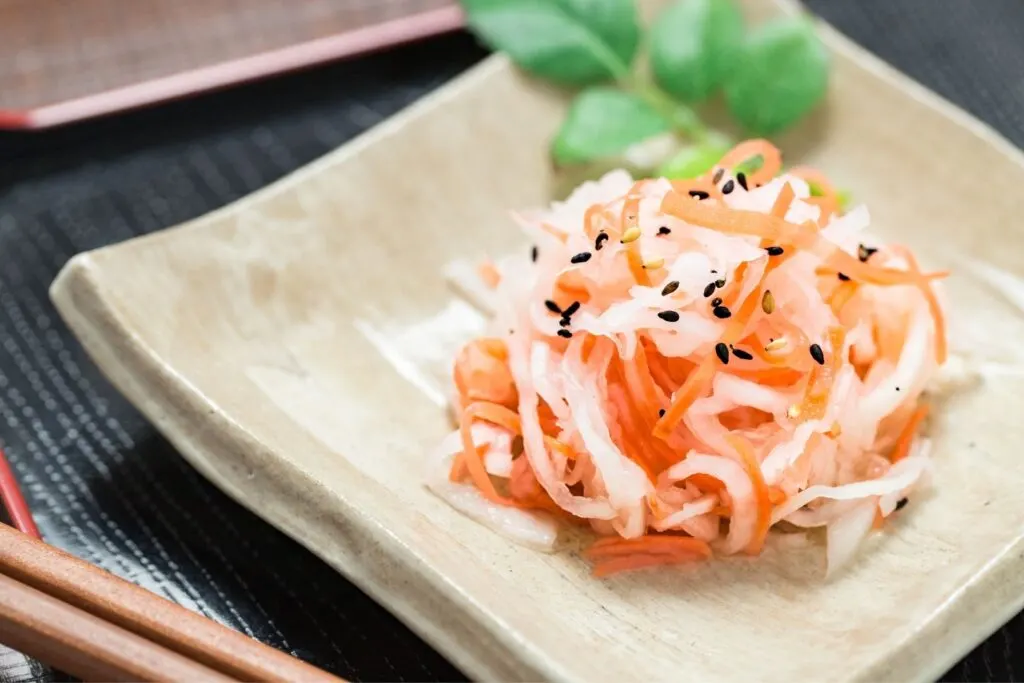
Datemaki
Datemaki (だてまき, 伊達巻) is a sweet rolled omelette made from egg and hanpen fish cake. It is rolled up using a bamboo mat to produce indentations that make the cut omelette log look like an old paper scroll. Datemaki therefore symbolizes literary and scholastic pursuits.
More pronounced “scroll-like” edges can be achieved by using an onisudare, a special bamboo mat with deep notches.
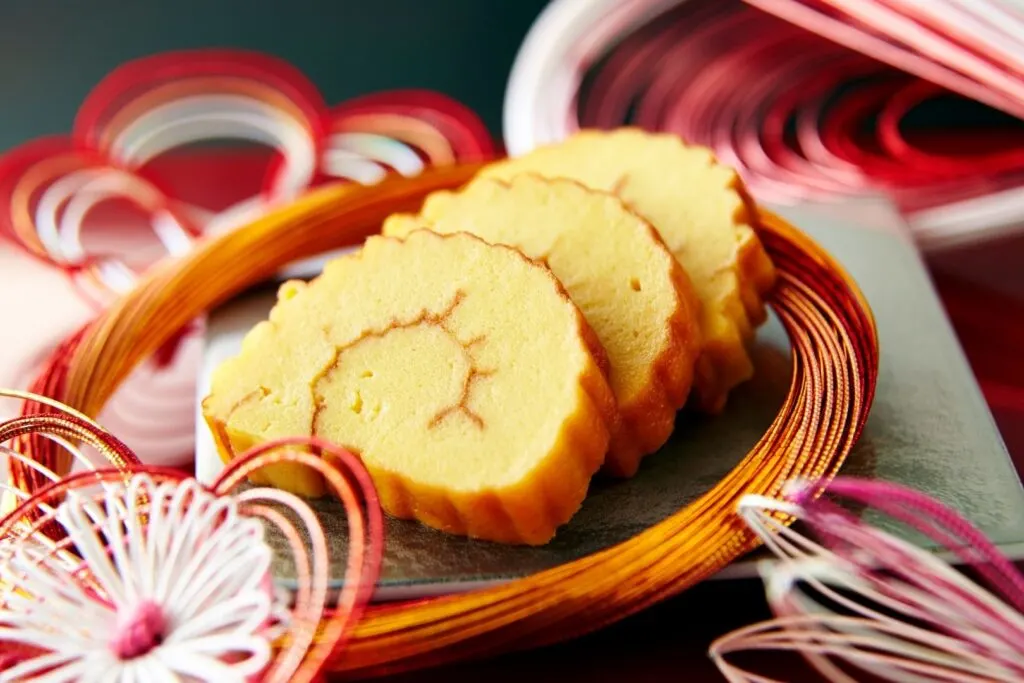
Kurikinton
If financial success is on your mind for the coming year, be sure to eat some kurikinton (くりきんとん, 栗金団).
Literally “chestnut gold dumpling”, kurikinton is candied chestnuts, either served on their own or in a sweet potato mash. The chestnuts look like gold nuggets or old coins, and the overall golden hue of this dish is said to represent wealth and financial prosperity.
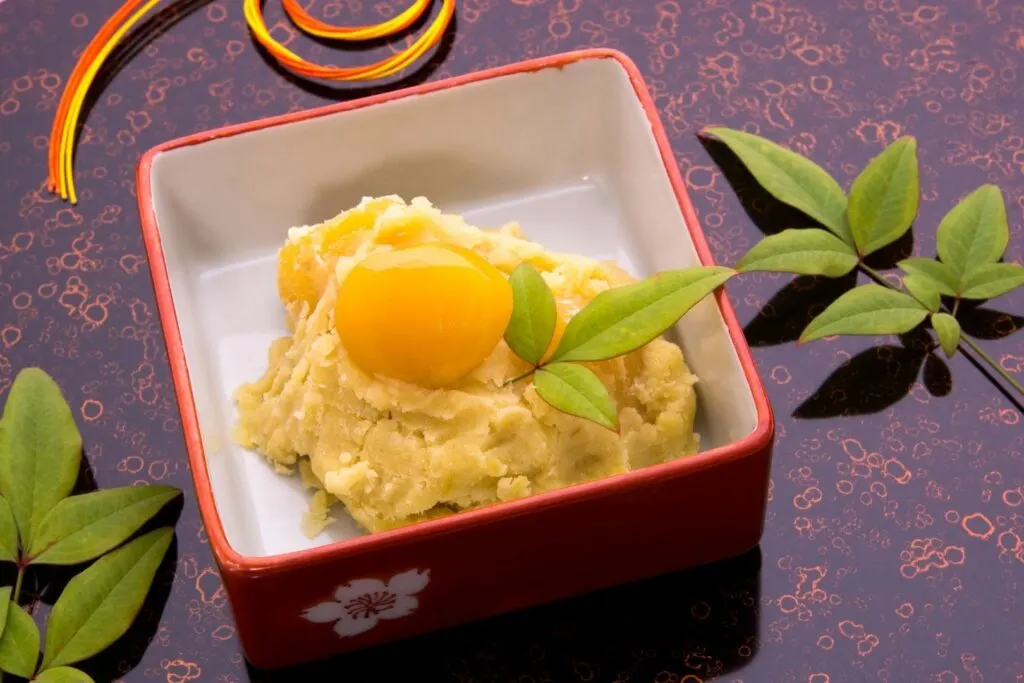
Kuwai
The career-oriented shouldn’t forget a helping of kuwai (くわい) or the Sagittaria plant, also known as Arrowhead in English. This aquatic plant produces an edible tuber with a single long shoot.
In a culture where staying in the one company from graduation until retirement, or at least limiting job movements, is still idealized, kuwai is said to represent a long and steady career.
In osechi, kuwai is peeled and then simmered in a broth of dashi, sugar, mirin, and soy sauce.
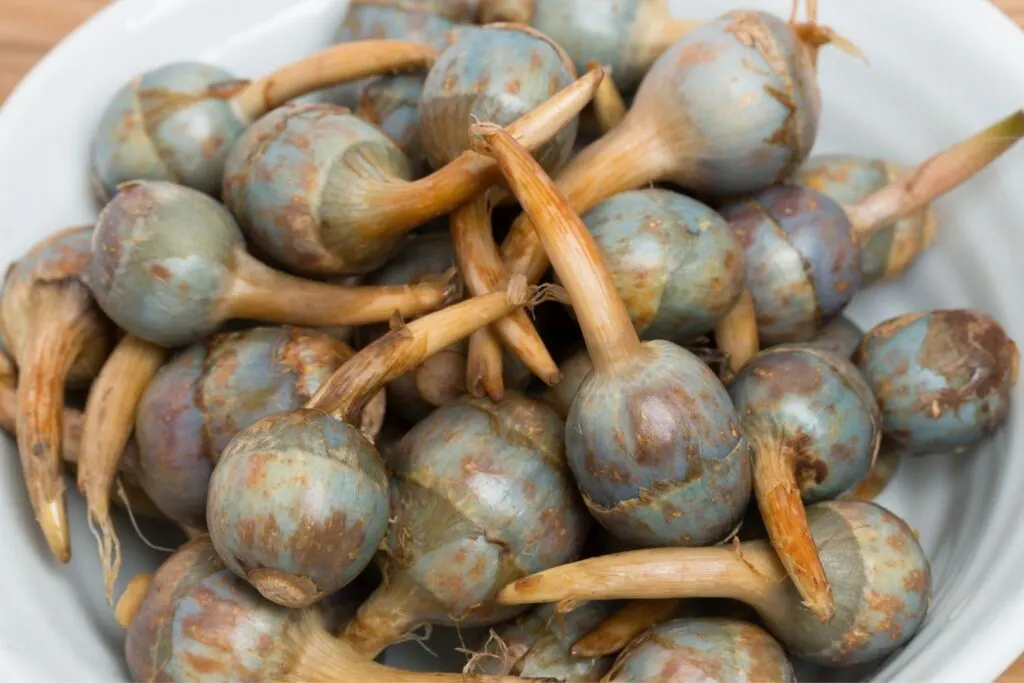
Gobo
Gobo (gobō, ごぼう, 牛蒡) or burdock root is renowned for having strong roots and being difficult to cut down. It is eaten as an osechi dish to symbolize both physical and inner strength, as well as a life of stability.
Tataki gobo (たたき牛蒡), as this dish is known, is pounded, then boiled and simmered in a soy sauce and dashi broth, and dressed in a sesame sauce.
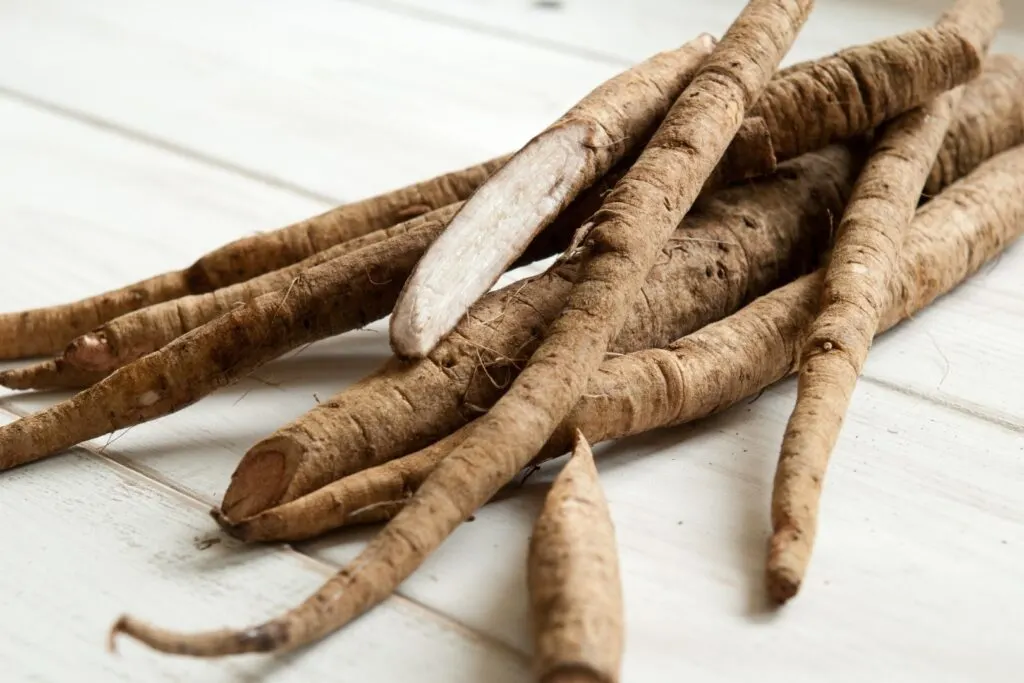
Kobumaki
Kobumaki (こぶまき, 昆布巻き) are rolls of edible kelp (kombu) tied with kanpyō (dried gourd) simmered in soy sauce, mirin, sake, rice vinegar and sugar, and often stuffed with salted salmon.
This dish is said to bring happiness in the year to come as kobu (another word for kombu or kelp) is part of the Japanese word yorokobu, which means happy or joyful.
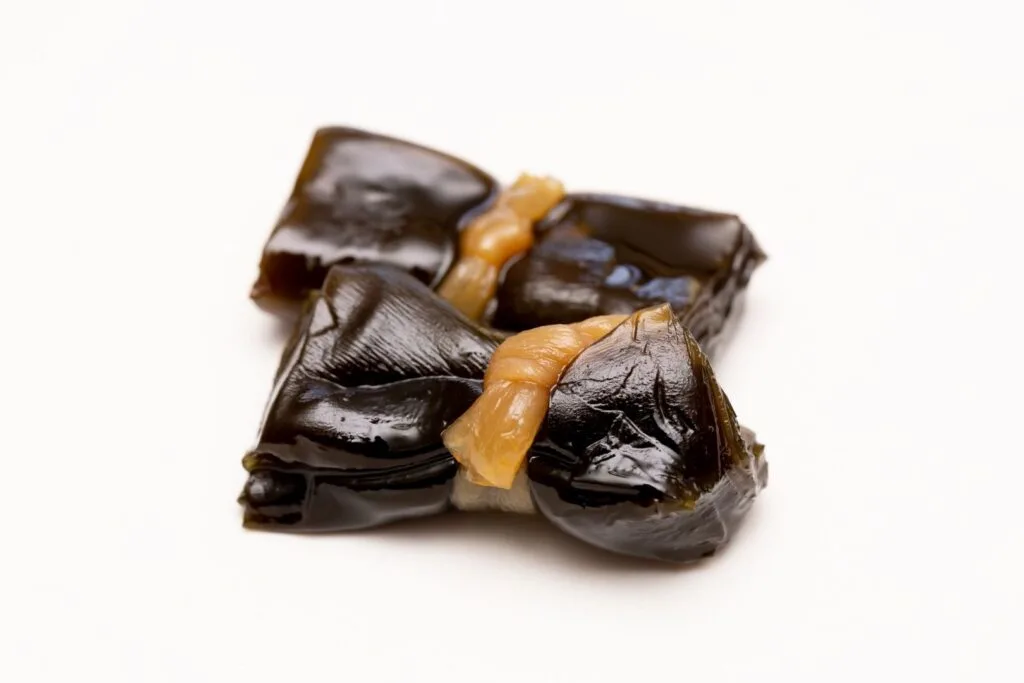
Tai
Tai (たい, 鯛), or sea bream, is a fish for celebration in Japan. A play on words, it derives from medetai, meaning “to celebrate”.
It is often eaten on special occasions such as weddings and is one of the dishes served as okuizome, the food a baby is traditionally fed as part of a custom marked 100 days after they are born.
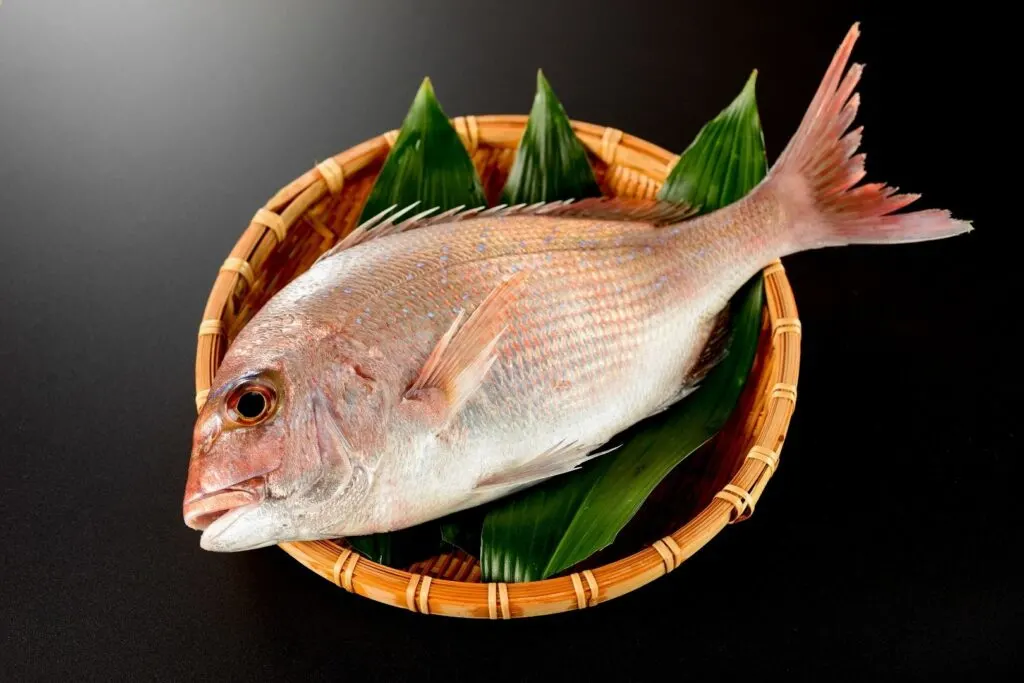
Ebi
Ebi (えび, 海老) or shrimp is said to resemble the lean of an elderly person and the antenna like a long beard or whiskers, and hence is eaten over the New Year as a wish for a long life.
They are a focal point of the beautifully-presented jubako box and are another opportunity for the auspicious red and white to be incorporated. You’ll also see them frequently added as tempura to the toshikoba soba eaten on New Year’s Eve. Ise ebi (いせ・えび, 伊勢海老) or the spiny lobster is also present in many of the more elaborate osechi offerings. They can live for up to twenty years and hence are another natural symbol of longevity.
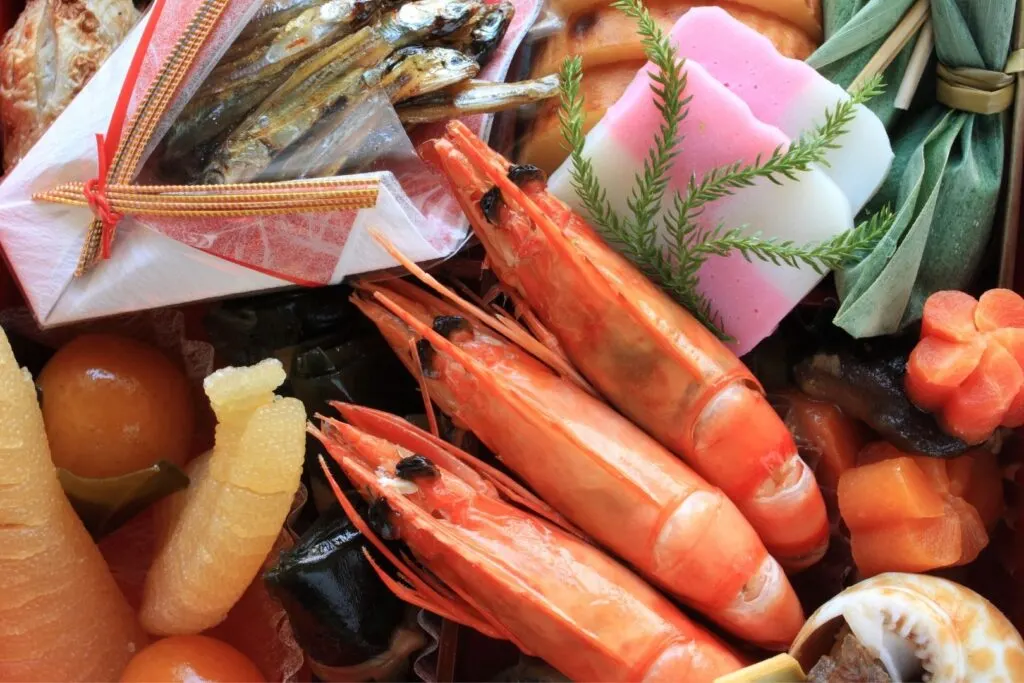
Buri
The Japanese have different words for some fish depending on their age. These types of fish are known as shusse-uo, literally meaning “successful fish”, because their names change as they grow to the next stage of development. One such fish is buri (ブリ), which specifically refers to a fully-grown adult Japanese amberjack or yellowtail.
Eating buri over New Year is therefore said to symbolize growth, development and promotion.
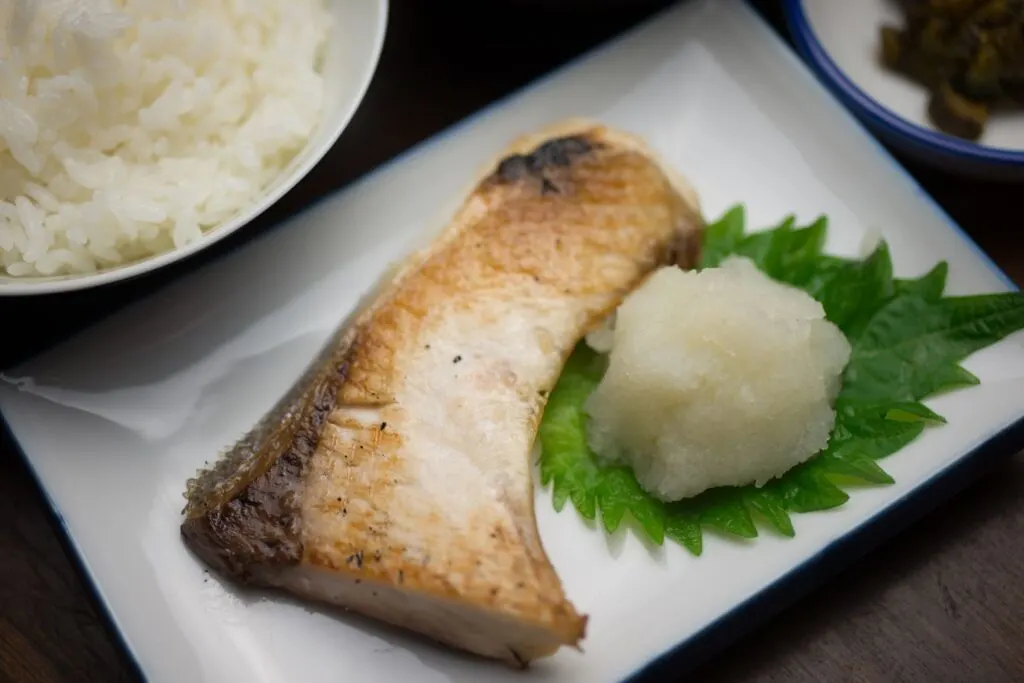
Renkon
If you’re hoping for less challenges to be thrown your way in the coming year, make sure you eat your renkon. In osechi, this dish is referred to as Su Renkon (す・れんこん, 酢蓮根) or pickled lotus root as it has been marinated in sweet vinegar.
Lotus root has distinctive holes that you can see right through without interference. It is therefore eaten to wish for a happy future without obstacles or at the very least to be able to see those obstacles clearly ahead of time.
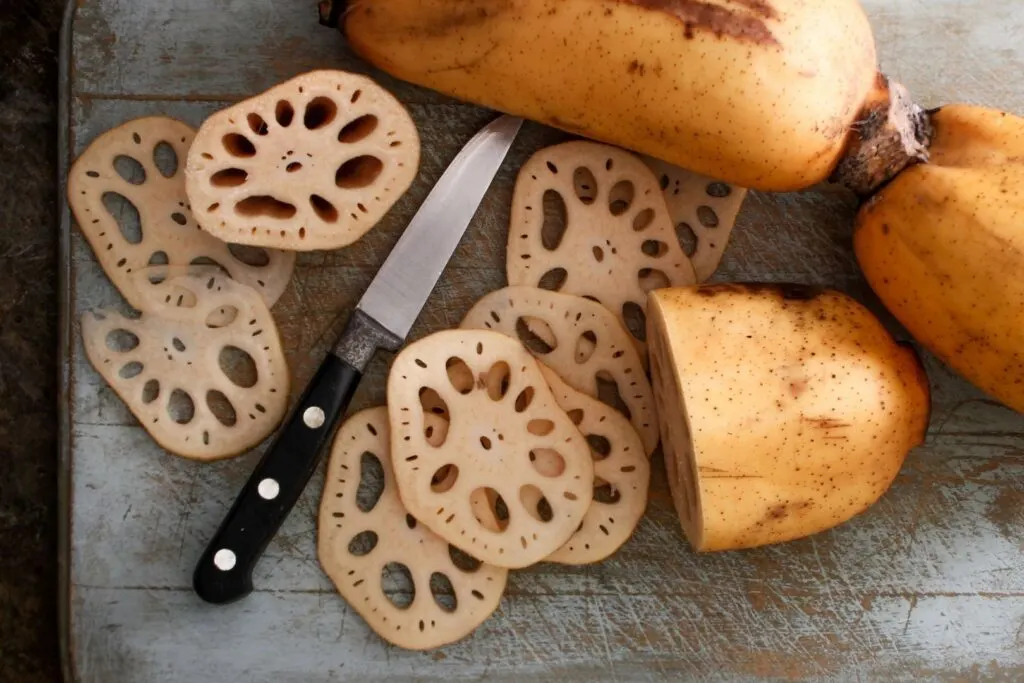
Osechi can contain other dishes and ingredients, but these represent some of the most typical and auspicious. Various simmered vegetables in addition to the root vegetables mentioned here, such as carrot and mushroom are also common, and roast beef is an increasingly popular addition to osechi ryori boxes.
But even after three days of osechi, there is one more Japanese New Year food tradition to round out the celebrations.
January 11th: Kagami mochi
There are various auspicious objects used as decorations during the New Year celebrations to bring good fortune. One of these is Kagami mochi (鏡餅), which is made of two rice cakes (mochi), the smaller one placed on the larger one, and topped with a daidai (橙), or Japanese bitter orange, considered a good omen because if it is written using different characters, 代々, it can be translated as “generation to generation”.
The mochi represent the past year and the year to come, so combined with the orange symbolizes the continuity of the family over the years. It is placed in the kamidana or the miniature elevated Shinto shrine in homes and businesses. The decoration is said to gave gotten its name from the stacked mochi‘s resemblance to the copper round mirrors used during the Muromachi period (approximately 1336-1573), also known as kagami.
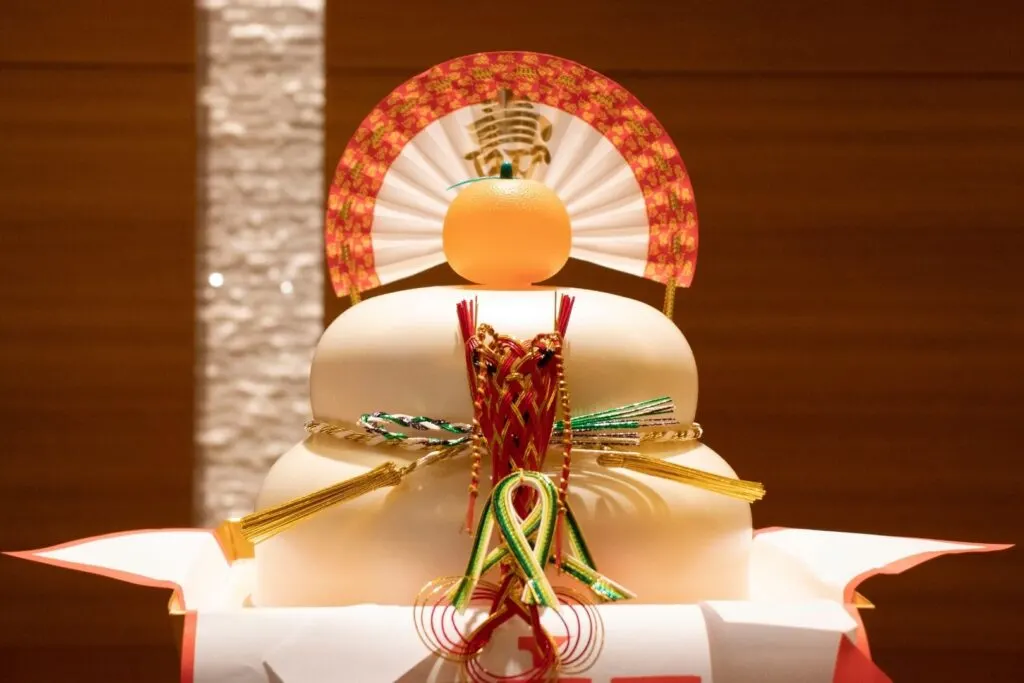
On January 11th (or on the second Saturday or Sunday in January), a ritual known as kagami-biraki (“the opening of the mirror”) takes place and the kagami mochi are split by hand or hammer, and then cooked and eaten with sweet red beans. A knife is never used as that would represent the severing of family ties.
Have you tried osechi ryori or other Japanese New Year cuisine? Which dish would you most like to try?
Pin me for later
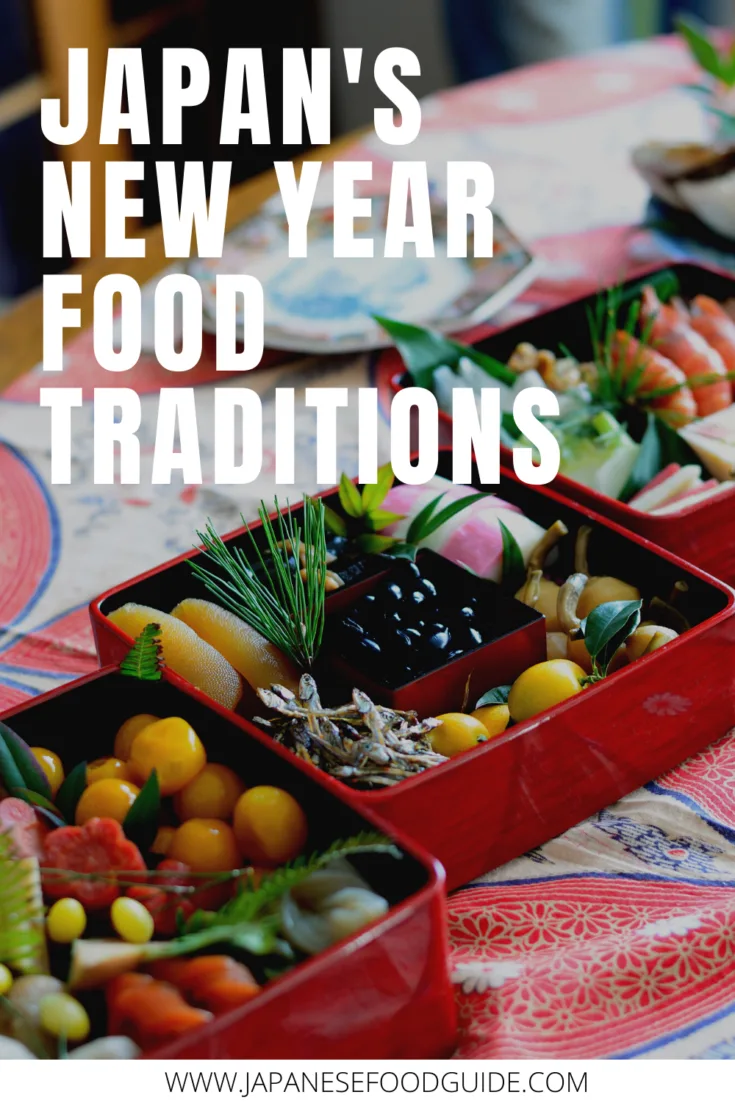
Japanese Food Guide has been listed in Feedspot’s Top 45 Japanese Food Blogs & Websites. Check it out!
Jessica Korteman is a seasoned travel writer from Melbourne, Australia. She has spent a decade living, working and traveling in Japan, and specializes in Japanese culture, festivals and events, and travel destinations both on and off the beaten path throughout the country.
She is the Founder and Editor of Japanese Food Guide.
